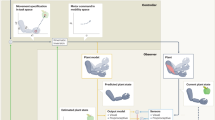Abstract
The inanimate world, including Man's wheeled vehicles, follow the classical mechanical laws: trajectories of objects in phase-space are predictable on the basis of the vectors of forces acting on the objects. Animal locomotion does not involve wheels, but relies on antagonistic contractile fibre systems, and defies prediction of trajectories. These features are tied up with the faculty of “immediate steering” in response to momentaneous physiological and environmental stimuli. Thus, animal motor systems have two relatively independent inputs: the sensory/information system, which is the cause for specific trajectories, and the “erfolg system” which permits for the execution of the thus instructed motion. The problem of relative energetic magnitudes between the two systems — in that the causative system involves small, yet the executive system large energies — is specially considered in relation to locomotion by antagonistically functioning mechanical elements.
Similar content being viewed by others
References
Bohr, N. (1934). Atomic Theory and the Description of Nature.- Cambridge University Press.
Brillouin, L. (1951). Maxwell's Demon cannot operate: information and entropy. - J. appl. Physics 22: 334–337.
Delbrück, M. (1966). A physicist looks at biology. In: J. Cairns, G.S. Stent and J.D. Watson, eds. Phage and the Origin of Molecular Biology.- Cold Spring Harbour Laboratory for Quantitative Biology.
Walker, I. (1972). Biological memory.- Acta biotheor. 21: 203–235.
Walker, I. (1976). Maxwell's Demon in biological systems.- Acta biotheor. 25: 103–110.
Walker, I. (1983). Complex-irreversibility and evolution.- Experientia 39: 806–813.
Author information
Authors and Affiliations
Additional information
Classical mechanics is an adequate model to develope the following considerations; it is not necessary to invoke relativity theory and curved spaces.
Rights and permissions
About this article
Cite this article
Walker, I. Ideas in theoretical biology Why legs and not wheels?. Acta Biotheor 39, 151–155 (1991). https://doi.org/10.1007/BF00046597
Received:
Issue Date:
DOI: https://doi.org/10.1007/BF00046597




